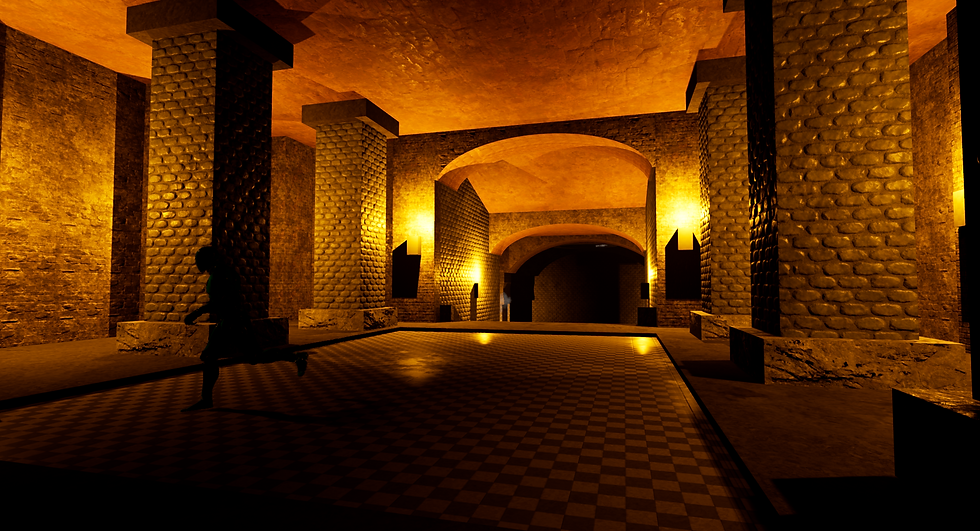Space Engineer: A redirected movement space simulation.
- Draven Lee

- Dec 6, 2021
- 4 min read
Updated: Dec 8, 2021
Space Engineer is a Virtual Reality piece I developed at the University of West England. The game is set in the 2060's when Humanity has finally achieved the technology to travel at faster than light speeds, and it's decided to visit the nearest star system: Alpha Centauri.
When approaching Proxima B, the station is hit by a solar flare, and consequently, the ship systems are knocked out, leaving you as the sole engineer; responsible for saving the ship from catastrophe.
Space Engineer is an experiment with Redirection in Virtual Reality. The Oculus Quest 2 was chosen as the medium for this experience, due to it being wireless, it was easy to set up, and users wanted to move around the environment naturally. When users were tested with an Oculus CV1 setup, the result of the testing was that users were afraid to move due to the tether being in the way. I eventually experimented with using Redirection in small spaces, due to unknowns in the exhibition space, I looked at solutions in a 2-meter space. I came across several other projects that used techniques to redirect or create the illusion that the user is progressing in a large 3d space in a 2-meter environment.
Here is a rough sketch of the original map idea for Space Engineer.

The user is to move through a corridor, that will use rotational gains, a method where the environment is slightly rotated so the user walks in a curve, the rotation is subtle, so the user has the illusion of walking in a straight line. this was followed by a room with puzzles, allowing the user to progress further down the corridor.
in a 9meter space, some users experienced severe motion sickness during the tests, others who were more familiar with VR gaming were able to cope with the strain but likened it to the sensation of falling in a virtual environment, such as those found in Boneworks and Blade and Sorcery.

I retried this approach with a simple hallway using an avatar to keep the user's attention, however, this failed and users still noticed the rotation and/or got sick. I eventually made the move from Unity to Unreal for this project, Unreal has a variety of nodes in Blueprint that allows the user to access Nodes and information from the Oculus Guardian, I took this node and used is to get the vector for the centre of the play space. this however proved to be too time-consuming for the time left on the project, and an alternative solution had to be found.
Another experimental method is to use eye-tracking, this allows the system to more accurately predict where the user intends to go, and the easiest method is to redirect them towards the centre of their play space. however, this feature is not included in the Oculus Quest. Another solution is using a virtual avatar to guide the player, or to make them change paths when they get too close to the boundary.

The solution I found was in another experimental VR game, where verticality was used as a redirector, the user would be guided around the environment through climbing. the experience was tailored to a small space and used non-euclidean geometry in some sections to give the player an impression of going through a bigger space in a smaller space. Upon giving this approach to Space Engineer, I was able to create a similar experience and add more user interaction, such as drawers, and drawers. One drawback of this was that users felt that they were moving through a more confined space, but by using tricks such as Teleporting the user to another location subtly in the virtual world, users had the impression of moving through a larger space than what they were in the real world.


Some of the original ideas conveyed in the mood boards of the original experience idea were hard to convey in the smaller space, however, it was important to make the space seem alive and used. This was a lot harder, however, due to tricks such as Render Targets and fake hallways, it was easy to convince users they were in a larger space. Although sadly Render Target Cameras were eventually cut from the experience due to the large hit they had on performance on an Oculus Quest 2. Performance was a major hindrance in the development for the quest, with certain actions and events having to be removed due to particles etc having performance impacts.

Creating the Space environment was simple thanks to tools like Spacescape, I was able to quickly create a space environment, and use a skysphere to import the texture, and set it as an emissive skybox, users commented on this feature quite often when gazing out windows in testing, being impressed by how it appears in virtual reality.
For the posters and handouts, I wanted to have everything created in Engine. However as the spaceship was never seen from the outside in-game, I created an outline using Photoshop of a spaceship and overlayed it on a space environment I had created using Unreal Engine.































Comments